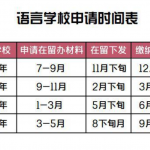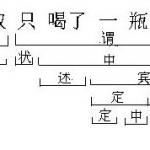胡壮麟语言学教程大纲分析及试题(3)
本站小编 免费考研网/2019-03-17
36. What are the three kinds of antonymy? (武汉大学,2004)
VI. Analyze the following situation. (20%)
37. For each group of words given below, state what semantic property or properties are shared by the (a) words and the (b) words, and what semantic property or properties distinguish between the classes of (a) words and (b) words.
(1) a. bachelor, man, son, paperboy, pope, chief
b. bull, rooster, drake, ram
(2) a. table, stone, pencil, cup, house, ship, car
b. milk, alcohol, rice, soup
(3) a. book, temple, mountain, road, tractor
b. idea, love, charity, sincerity, bravery, fear (青岛海洋大学,1999)
Test Six: Pragmatics
I. Choose the best answer. (20%)
1. What essentially distinguishes semantics and pragmatics is whether in the study of meaning _________ is considered.
A. reference B. speech act C. practical usage D. context
2. A sentence is a _________ concept, and the meaning of a sentence is often studied in isolation.
A. pragmatic B. grammatical C. mental D. conceptual
3. If we think of a sentence as what people actually utter in the course of communication, it becomes a (n) _________.
A. constative B. directive C. utterance D. expressive
4. Which of the following is true?
A. Utterances usually do not take the form of sentences.
B. Some utterances cannot be restored to complete sentences.
C. No utterances can take the form of sentences.
D. All utterances can be restored to complete sentences.
5. Speech act theory did not come into being until __________.
A. in the late 50’s of the 20the century B. in the early 1950’s
C. in the late 1960’s D. in the early 21st century
6. __________ is the act performed by or resulting from saying something; it is the consequence of, or the change brought about by the utterance.
A. A locutionary act B. An illocutionary act
C. A perlocutionary act D. A performative act
7. According to Searle, the illocutionary point of the representative is ______.
A. to get the hearer to do something
B. to commit the speaker to something’s being the case
C. to commit the speaker to some future course of action
D. to express the feelings or attitude towards an existing state of affairs
8. All the acts that belong to the same category share the same purpose, but they differ __________.
A. in their illocutionary acts B. in their intentions expressed
C. in their strength or force D. in their effect brought about
9. __________ is advanced by Paul Grice
A. Cooperative Principle B. Politeness Principle
C. The General Principle of Universal Grammar D. Adjacency Principle
10. When any of the maxims under the cooperative principle is flouted, _______ might arise.
A. impoliteness B. contradictions
C. mutual understanding D. conversational implicatures
II. Decide whether the following statements are true or false. (10%)
11. Pragmatics treats the meaning of language as something intrinsic and inherent.
12. It would be impossible to give an adequate description of meaning if the context of language use was left unconsidered.
13. What essentially distinguishes semantics and pragmatics is whether in the study of meaning the context of use is considered.
14. The major difference between a sentence and an utterance is that a sentence is not uttered while an utterance is.
15. The meaning of a sentence is abstract, but context-dependent.
16. The meaning of an utterance is decontexualized, therefore stable.
17. Utterances always take the form of complete sentences
18. Speech act theory was originated with the British philosopher John Searle.
19. Speech act theory started in the late 50’s of the 20th century.
20. Austin made the distinction between a constative and a performative.
III. Fill in the blanks. (20%)
21. The notion of __________ is essential to the pragmatic study of language.
22. If we think of a sentence as what people actually utter in the course of communication, it becomes an __________.
23. The meaning of a sentence is __________, and decontexualized.
24. __________ were statements that either state or describe, and were thus verifiable.
25. __________ were sentences that did not state a fact or describe a state, and were not verifiable.
26. A(n) __________ act is the act of uttering words, phrases, clauses. It is the act of conveying literal meaning by means of syntax, lexicon and phonology.
27. A(n) __________ act is the act of expressing the speaker’s intention; it is the act performed in saying something.
28. A(n) _________ is commit the speaker himself to some future course of action.
29. A(n) ________ is to express feelings or attitude towards an existing state.
30. There are four maxims under the cooperative principle: the maxim of __________, the maxim of quality, the maxim of relation and the maxim of manner.
IV. Explain the following terms, using examples. (20%)
31. Conversational implicature
32. Performative
33. Locutionary act
34. Q-principle (Horn)
V. Answer the following questions. (20%)
35. Explain the following remarks with examples or make some comments.
“Both semantics and pragmatics are concerned with meaning, but the difference between them can be traced to two different uses of the verb mean: (a) What does X mean? (b) What did you mean by X?” (东北师范大学,2006)
36. Do you think B is cooperative in the following dialogue? Support your argument with Cooperative Principle. (南开大学,2004)
A: When is the bus coming?
B: There has been an accident further up the road.
VI. Analyze the following situation. (20%)
37. What is the function of context in communication? Try to explain the following utterances rather than just state facts.
(1) The room is messy.
(2) It would be good if she had a green skirt on.
Test Seven: Language, Culture and Society
I. Choose the best answer. (20%)
1. _______ is concerned with the social significance of language variation and language use in different speech communities.
A. Psycholinguistics B. Sociolinguistics
C. Applied linguistics D. General linguistics
2. The most distinguishable linguistic feature of a regional dialect is its __________.
A. use of words B. use of structures
C. accent D. morphemes
3. __________ is speech variation according to the particular area where a speaker comes from.
A. Regional variation B. Language variation
C. Social variation D. Register variation
4. _______ are the major source of regional variation of language.
A. Geographical barriers
B. Loyalty to and confidence in one’s native speech
C. Physical discomfort and psychological resistance to change
D. Social barriers
5. _________ means that certain authorities, such as the government choose, a particular speech variety, standardize it and spread the use of it across regional boundaries.
A. Language interference B. Language changes
C. Language planning D. Language transfer
6. _________ in a person’s speech or writing usually ranges on a continuum from casual or colloquial to formal or polite according to the type of communicative situation.
A. Regional variation B. Changes in emotions
C. Variation in connotations D. Stylistic variation
7. A ____ is a variety of language that serves as a medium of communication among groups of people for diverse linguistic backgrounds.
A. lingua franca B. register
C. Creole D. national language
8. Although _______ are simplified languages with reduced grammatical features, they are rule-governed, like any human language.
A. vernacular languages B. creoles C. pidgins D. sociolects
9. In normal situations, ____ speakers tend to use more prestigious forms than their ____ counterparts with the same social background.
A. female; male B. male; female C. old; young D. young; old
10. A linguistic _______ refers to a word or expression that is prohibited by the “polite” society from general use.
A. slang B. euphemism C. jargon D. taboo
II. Decide whether the following statements are true or false. (10%)
11. Language as a means of social communication is a homogeneous system with a homogeneous group of speakers.
12. The goal of sociolinguistics is to explore the nature of language variation and language use among a variety of speech communities and in different social situations.
13. From the sociolinguistic perspective, the term “speech variety” can not be used to refer to standard language, vernacular language, dialect or pidgin.
14. The most distinguishable linguistic feature of a regional dialect is its grammar and uses of vocabulary.
15. A person’s social backgrounds do not exert a shaping influence on his choice of linguistic features.
16. Every speaker of a language is, in a stricter sense, a speaker of a distinct idiolect.
17. A lingua franca can only be used within a particular country for communication among groups of people with different linguistic backgrounds.
18. A pidgin usually reflects the influence of the higher, or dominant, language in its lexicon and that of the lower language in their phonology and occasionally syntax.
19. Bilingualism and diglossia mean the same thing.
20. The use of euphemisms has the effect of removing derogatory overtones and the disassociative effect as such is usually long-lasting.
III. Fill in the blanks. (20%)
21. The social group isolated for any given study is called the speech __________.
22. Speech __________ refers to any distinguishable form of speech used by a speaker or group of speakers.
23. From the sociolinguistic perspective, a speech variety is no more than a __________ variety of a language.
24. Language standardization is also called language __________.
25. Social variation gives rise to __________ which are subdivisible into smaller speech categories that reflect their socioeconomic, educational, occupational background, etc.
26. __________ variation in a person’s speech or writing usually ranges on a continuum from casual or colloquial to formal or polite according to the type of communicative situation.
27. A regional dialect may gain status and become standardized as the national or __________ language of a country.
28. The standard language is a __________, socially prestigious dialect of language.
29. Language varieties other than the standard are called nonstandard, or __________ languages.
30. A pidgin typically lacks in __________ morphemes.
IV. Explain the following terms, using examples. (20%)
31. Lingua franca
32. Regional dialect
33. Register
34. Sociolinguistics
V. Answer the following questions. (20%)
35. Is American English superior to African English? Why or why not? (中国人民大学,2003)
36. If we take it as rule that language is intimately related to culture, then how do the kinship words, such as uncle and aunt, reflect the cultural differences between English and Chinese? (东北师范大学,2004)
VI. Analyze the following situation. (20%)
37. Explain the differences between registers and regional/social dialects. Give examples if necessary. (东北师范大学,2005)
Test Eight: Theories and Schools of Modern Linguistics
I. Choose the best answer. (20%)
1. The person who is often described as “father of modern linguistics” is __________..
A. Firth B. Saussure C. Halliday D. Chomsky
2. The most important contribution of the Prague School to linguistics is that it sees language in terms of __________.
A. function B. meaning C. signs D. system
3. The principal representative of American descriptive linguistics is __________.
A. Boas B. Sapir C. Bloomfield D. Harris
4. Generally speaking, the __________ specifies whether a certain tagmeme is in the position of the Nucleus or of the Margin in the structure.
A. Slot B. Class C. Role D. Cohesion
5. __________ Grammar is the most widespread and the best understood method of discussing Indo-European languages.
A. Traditional B. Structural C. Functional D. Generative
6. __________ Grammar started from the American linguist Sydney M. Lamb in the late 1950s and the early 1960s.
相关话题/语言学
语言学纲要学习指导书练习答案(整理版)
《语言学概论》学习辅导书参考答案(导言) 一、名词解释(20分,每小题4分) 1.语言学:就是以语言为研究对象的科学,研究语言的本质、语言的结构和发展规律。 2.小学:指我国传统的语文学,包括文字学、音韵学、训诂学三方面的内容。 3.专语语言学:也叫具体语言学、个别语言学,以一种(或几种有联系的)语言 ...专业课考研资料 本站小编 免费考研网 2019-02-13华师语言所学硕2019年语言学概论考研真题
一、填空题所谓递归性,是指相同的结构规则可以( ),可以由( )扩展成层层嵌套的( )。语言系统可以分为( )、( )、( )等子系统。黏着语又称( ),其特点是通过附加多种( )来表示各种( )。音质的不同取决于三方面的条件:一是( ),二是( ),三是( )的形状。根据义项之间不同的关 ...专业课考研资料 本站小编 免费考研网 2019-01-03丁言仁《英语语言学纲要》笔记和课后习题详解
目录封面内容简介目录第1章 我们身边的语言 1.1 复习笔记 1.2 课后习题详解第2章 英语语法 2.1 复习笔记 2.2 课后习题详解第3章 英语语音系统和书写系统 3.1 复习笔记 3.2 课后习题详解第4章 英语语义和词汇 4.1 复习笔记 4.2 课后习题详解第5章 语言在语境中的应用 5 ...辅导考试考研资料 本站小编 免费考研网 2018-11-30扬州大学文学院816语言学理论历年考研真题汇编
目录封面内容简介目录2014年扬州大学文学院816语言学理论考研真题2015年扬州大学文学院816语言学理论考研真题2016年扬州大学文学院816语言学理论考研真题2017年扬州大学文学院816语言学理论考研真题2018年扬州大学文学院816语言学理论考研真题内容简介本书收录了扬州大学文学院&ldq ...辅导考试考研资料 本站小编 免费考研网 2018-11-30江西师范大学文学院语言学概论历年考研真题汇编
目录封面内容简介目录2012年江西师范大学文学院语言学概论考研真题2013年江西师范大学文学院语言学概论考研真题2014年江西师范大学文学院语言学概论考研真题2015年江西师范大学文学院语言学概论考研真题2016年江西师范大学文学院语言学概论考研真题2017年江西师范大学文学院语言学概论考研真题内容 ...辅导考试考研资料 本站小编 免费考研网 2018-11-30日本语言学校介绍及之后的升学之路
 随着大量留学生涌入日本,日本的语言学校可以说是遍地开花。很多学生和家长对语言学校始终保持疑虑,担心在日本读语言学校对学生升学帮助不大还浪费时间,今天小编就系统的介绍一下日本的语言学校及语言学校毕业后如何申请修士。 语言学校的作用: 1. 学日语: 顾名思义,语言学校是学日语的地方,如果日语不 ...日本留学 本站小编 免费考研网 2018-11-18
随着大量留学生涌入日本,日本的语言学校可以说是遍地开花。很多学生和家长对语言学校始终保持疑虑,担心在日本读语言学校对学生升学帮助不大还浪费时间,今天小编就系统的介绍一下日本的语言学校及语言学校毕业后如何申请修士。 语言学校的作用: 1. 学日语: 顾名思义,语言学校是学日语的地方,如果日语不 ...日本留学 本站小编 免费考研网 2018-11-182019年北京邮电大学817英语语言学与文学基础考研大纲
817英语语言学与文学基础一、考试要求要求考生系统地掌握大学本科期间所学的语言学概论和英美文学的基本概念和知识,并且语言学方向考生能够运用语言学基本规则和理论分析一般的语言现象,文学方向考生能够运用所学知识对作家、作品和文学人物进行初步的分析、批判。二、考试内容语言的概念、特征以及各分支的概念、研究 ...专业课大纲 本站小编 免费考研网 2018-11-042019年浙江财经大学语言学概论和现代汉语考研初试大纲
《语言学概论和现代汉语》考试大纲一、考试目的和要求本课程涵盖汉语言文学专业本科阶段现代汉语和语言学概论的主要内容,是汉语言文学专业的核心课程,也是汉语言文字学专业学生必须掌握的基础性课程。考试目的:测试学生运用语言理论分析和解决语言问题的基本能 ...专业课大纲 本站小编 免费考研网 2018-11-042019年浙江财经大学语言学理论考研初试大纲
《语言学理论》考试大纲一、考试目的和要求本课程涵盖汉语言文学专业本科阶段语言学概论的主要内容,是汉语言文学专业的核心课程,也是汉语言文字学专业学生必须掌握的基础性课程。考试目的:测试学生运用语言理论分析和解决语言问题的基本能力,并由此判断学生是否具有进一步深造的基本素质和 ...专业课大纲 本站小编 免费考研网 2018-11-042019年华侨大学810语言学概论考研初试大纲
2019年华侨大学硕士研究生招生考试初试自命题科目考试大纲招生学院: 华文学院 招生专业: 华语与华文教育科目名称: 语言学概论一、考试形式与试卷结构(一)试卷满分值及考试时间本试卷满分为150分,考试时间为180分钟。(二)答题方式答题方式为闭卷、笔试。试卷由试题和答题纸组成;答案必须写在答题纸( ...专业课大纲 本站小编 免费考研网 2018-11-042019年广东外语外贸大学050102语言学及应用语言学考研专业目录
据广东外语外贸大学研究生院消息,2019年广东外语外贸大学050102语言学及应用语言学考研专业目录已经公布,详情如下: ...专业目录 本站小编 免费考研网 2018-11-042019年广东外语外贸大学050211外国语言学及应用语言学考研专业目录
据广东外语外贸大学研究生院消息,2019年广东外语外贸大学050211外国语言学及应用语言学考研专业目录已经公布,详情如下: ...专业目录 本站小编 免费考研网 2018-11-04山东师范大学外国语学院818英语语言学及应用语言学基础(含英语语言学、应用语言学与英语教学基础知识)历年考研真题及详解
目录封面内容简介目录2017年山东师范大学818英语语言学及应用语言学基础考研真题及详解2018年山东师范大学818英语语言学及应用语言学基础考研真题及详解内容简介本书收集了山东师范大学外国语学院英语语言学及应用语言学基础(含英语语言学、应用语言学与英语教学基础知识)20 ...辅导考试考研资料 本站小编 免费考研网 2018-11-02南开大学2010年语言学概论考研真题
 2010年语言学概论真题答案 一.举例并解释 1.孤立语(知识点:书P112) 根据词的结构划分出来的一种语言类型,也叫词根语,指没有构形语素或基本无构形语素的语言。词不发生语法形式变化,语序和虚词成为基本的语法形式。如:汉语、越南语。 2.音位变体(知识点:书P71) 音位变体是属于一个音位的各 ...专业课考研资料 本站小编 免费考研网 2018-08-26
2010年语言学概论真题答案 一.举例并解释 1.孤立语(知识点:书P112) 根据词的结构划分出来的一种语言类型,也叫词根语,指没有构形语素或基本无构形语素的语言。词不发生语法形式变化,语序和虚词成为基本的语法形式。如:汉语、越南语。 2.音位变体(知识点:书P71) 音位变体是属于一个音位的各 ...专业课考研资料 本站小编 免费考研网 2018-08-26日本语言学校怎么样?日本语言学校考察实录
 启程 2017年5月9日,在北京首都国际机场跟男神博士见面,马上就要启程,真是心潮澎湃,愉悦的因子在身边跳跃。同博士在机场换了部分日币,就匆匆赶往登机处,开启了日本学校探访之行 抵达 下午2点到达日本成田国际机场,刚下飞机,就收到热心的双叶外国语老师的信息,已然在出口等待我们,当然同行的还有其他的老师。 ...日本留学 本站小编 免费考研网 2018-08-24
启程 2017年5月9日,在北京首都国际机场跟男神博士见面,马上就要启程,真是心潮澎湃,愉悦的因子在身边跳跃。同博士在机场换了部分日币,就匆匆赶往登机处,开启了日本学校探访之行 抵达 下午2点到达日本成田国际机场,刚下飞机,就收到热心的双叶外国语老师的信息,已然在出口等待我们,当然同行的还有其他的老师。 ...日本留学 本站小编 免费考研网 2018-08-24


